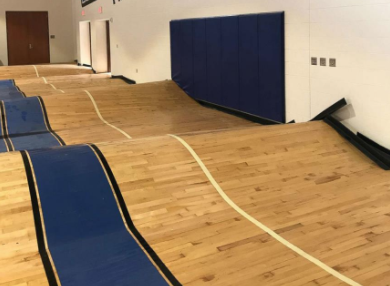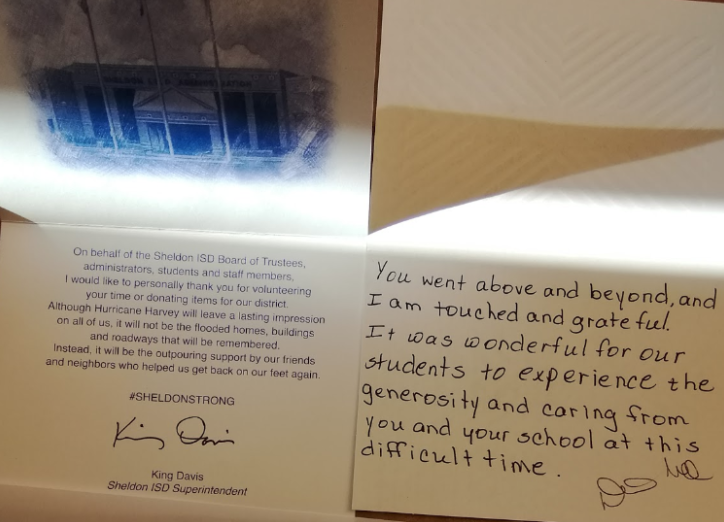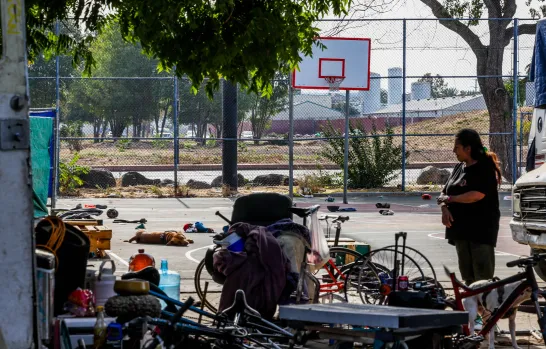Update on Pioneers to Panthers
From mid-August to early September last year, Category 4 storm Hurricane Harvey struck Central America and the United States. The Texas coast was one of the areas hit hardest, with Houston experiencing over 48 inches of cumulative rain, according to The New York Times. After contacting her relatives in Houston, Principal Kami Tomberlain discovered that the school they worked at, C.E. King High School, was flooded and heavily damaged. Tomberlain then reached out to King High School’s principal, Demetrius McCall, with the offer of “adopting” their school in what became the Pioneers to Panthers Program.
The initial goal for the donation drive was five thousand dollars, but the total amount collectively and individually raised by students and faculty at Cupertino High School exceeded double that value.

“We sent [a check] directly to the Sheldon ISD Foundation, [which was] deposited in the foundation account, and they sent the money to King High School. [CHS] donated together about 13 thousand dollars total,” Tomberlain said.
The storm forced students from campus, and many had to attend classes at two separate high schools nearby. Construction on the school gym and other damaged facilities began soon afterward.
In addition to rebuilding the school, money from the program and other donations went to resupplying the school with academic and extracurricular provisions such as textbooks, tables, calculators and musical instruments. Affected families from the school also received financial support in the form of gift cards, but progress has been slow for them.
Said McCall, “In the community, many of our families are still rebuilding the interior of their homes. Since many families were denied [Federal Emergency Management Agency] support, they are taking it one day at a time.”
King High School is well into its recovery process. All students returned to campus on Jan. 16, a week into the second semester. To make up for lost instructional time, the school schedule was revised last October, with fewer days of break in the second semester and five more minutes of school every day.

Said McCall regarding construction status, “Although our campus is not 100 percent complete, we feel very blessed to be back on familiar territory. Most of our learning spaces are being utilized, but our large common spaces such as the gyms and auditoriums will not be complete until the summer.”
Aside from materialistic outcomes, a large part of the recovery oriented around students’ mental health. After such a devastating event, it is natural to feel emotionally drained, especially for those who have not dealt with large-scale losses beforehand. Strong leadership and regular communication and meetings between administration, teachers and students ensured the transition back to everyday life was as smooth as possible.
“We want our students to feel safe in a supportive environment. We know that after this natural disaster, we must address their social and emotional needs before their educational [ones],” McCall said.
And with the work that has been completed so far, King students are feeling small rays of hope and relief. According to McCall, students were grateful to return to their school.
Said McCall, “Our students are happy to be on their campus […] They were truly concerned they would never see their high school campus again!”
C.E. King has expressed much gratitude towards its donors, producing a video for their website thanking all their contributors, and McCall sent a thank-you note to CHS specifically.
“[Outside assistance] has helped recovery tremendously. We could not have done it without the support of many generous folks such as the people of Cupertino High School,” McCall said, “Your generosity has made us think about ways we can give back to others.”
While the Sheldon district’s hard work, along with contributions from Cupertino and other communities, has fortunately helped C.E. King students in feeling more secure about their lives and education, King High School is still far from a full return to regularity. Landmarks of progress, like the students’ return to campus, can hopefully serve as indicators for a full, successful recovery.









